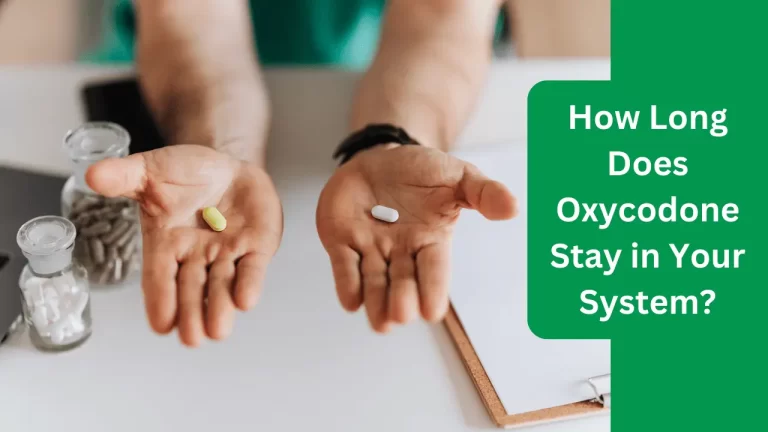
Oxycodone is a potent opioid painkiller that is prescribed to manage severe pain. It works by blocking pain signals to the brain, providing relief to patients. However, like all opioids, it has a high potential for abuse and addiction. For this reason, it’s important to know how long oxycodone stays in the body, as it can help prevent accidental overdose or failed drug tests. In this article, we will explore the factors that affect the duration of oxycodone in the system and provide a general timeline for its clearance.
What is Oxycodone?
Oxycodone is a powerful pain-relieving medication that belongs to a class of drugs known as opioids. It is typically prescribed by doctors to manage moderate to severe pain, such as pain caused by surgery, injury, or chronic conditions like cancer.
How does Oxycodone work?
Oxycodone works by binding to specific receptors in the brain and spinal cord known as mu-opioid receptors. These receptors are responsible for transmitting pain signals throughout the body. By binding to these receptors, oxycodone blocks the transmission of pain signals, reducing the perception of pain and producing feelings of relaxation and euphoria.
In addition to blocking pain signals, oxycodone also affects other areas of the brain, including the limbic system and the reward pathway. The limbic system is responsible for regulating emotions and mood, while the reward pathway is involved in reinforcing behaviours that are pleasurable or rewarding. By activating these areas of the brain, oxycodone can produce feelings of pleasure and euphoria, which can contribute to its addictive potential.
Oxycodone is available in various forms, including immediate-release tablets, extended-release tablets, and capsules. The immediate-release form is designed to provide quick relief of pain, while the extended-release form is designed to provide longer-lasting pain relief.
However, both forms of the medication work in a similar way by binding to mu-opioid receptors and blocking pain signals. It’s important to note that oxycodone is a potent medication that can cause serious side effects if not used properly, and it should only be taken under the guidance of a healthcare professional.
What is the Duration of Oxycodone in Your System?
The duration of oxycodone in the system can vary, but generally, it can be detected in urine for up to three to four days after the last dose, in blood for up to 24 hours, and in saliva for up to four days. However, the exact duration can depend on several factors such as age, weight, liver function, and frequency and amount of use.
What can be the side effects of Oxycodone?
Oxycodone, like all medications, can cause side effects. Some of the common side effects of oxycodone include:
Dizziness
Oxycodone can cause dizziness, lightheadedness, or fainting. This can be due to changes in blood pressure or because oxycodone affects the central nervous system.
Drowsiness
Oxycodone can cause drowsiness, fatigue, or lethargy, which can affect a person’s ability to drive or operate heavy machinery.
Nausea and vomiting
Oxycodone can cause gastrointestinal symptoms, such as nausea, vomiting, and constipation. These symptoms can be managed with medication and lifestyle changes.
Constipation
Oxycodone can cause constipation, which can be severe and long-lasting. This is because oxycodone slows down the movement of the digestive tract, leading to difficulty passing stool.
Headache
Oxycodone can cause headaches or migraines, which can be mild to severe and may last for several hours.
Dry mouth
Oxycodone can cause dry mouth or thirst, which can be managed with increased fluid intake and by using sugar-free gum or lozenges.
Itching
Oxycodone can cause skin irritation or itching, which can be managed with antihistamines or other medications.
Sweating
Oxycodone can cause excessive sweating, particularly at night or in warm temperatures.
Decreased appetite
Oxycodone can cause a loss of appetite or weight loss, which can be managed with dietary changes and medication adjustments.
Weakness or fatigue
Oxycodone can cause weakness or fatigue, which can affect a person’s ability to perform daily activities or exercise.
Difficulty sleeping
Oxycodone can cause difficulty falling asleep or staying asleep, which can lead to daytime drowsiness or fatigue. This can be managed with medication adjustments and lifestyle changes.
What are the 5 names of oxycodone?
Oxycodone is the generic name for this medication, but it’s also sold under various brand names. Here are five brand names of oxycodone:
- OxyContin
- Percocet
- Roxicodone
- Endocet
- Xtampza ER
What is the clearance time of oxycodone?
The clearance time of oxycodone can vary, but generally, it takes around 3 to 4 days for oxycodone to be eliminated from the body, although the exact time can depend on various factors such as age, weight, liver function, and frequency and amount of use.
Is oxycodone the same as Percocet?
Oxycodone and Percocet are not the same medication, but they do contain the same active ingredient. Oxycodone is a powerful opioid pain reliever that is available in both immediate-release and extended-release formulations. Percocet, on the other hand, is a combination of oxycodone and acetaminophen, a non-opioid pain reliever that is commonly used to treat fever and mild to moderate pain.
While both medications contain oxycodone, Percocet also contains acetaminophen, which can enhance the pain-relieving effects of the medication.
Frequently Asked Questions
Q1: What is oxycodone used for?
Ans: Oxycodone is used to relieve moderate to severe pain.
Q2: Is oxycodone addictive?
Ans: Yes, oxycodone is highly addictive and can lead to physical dependence and withdrawal symptoms.
Q3: How long does oxycodone stay in your system?
Ans: Oxycodone can stay in the system for around 3-4 days, but the duration can vary depending on various factors.
Q4: Can oxycodone be taken with other medications?
Ans: Oxycodone can interact with other medications, so it’s important to inform your doctor about all medications you are taking.
Q5: What are the common side effects of oxycodone?
Ans: Common side effects of oxycodone include dizziness, drowsiness, nausea, constipation, headache, and dry mouth.